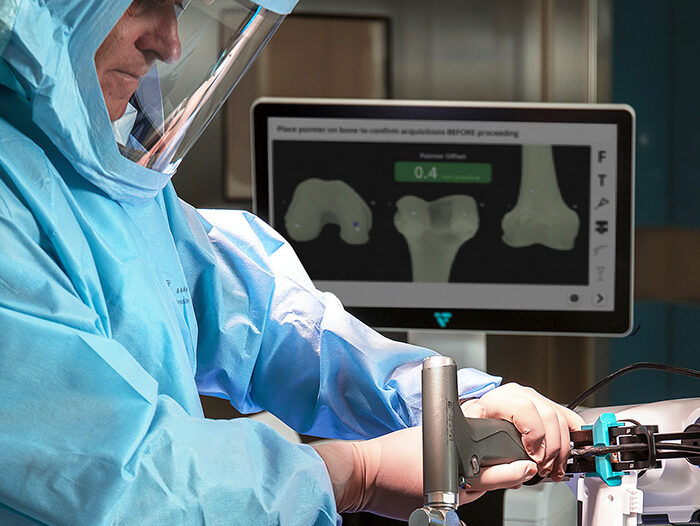
Churchill Hospital now offers the VELYS™ Robotic-Assisted Solution, the latest advancement that helps surgeons perform knee replacement surgery that is tailored to each patient with the goal to get patients back to life faster.
In 2020 there were approximately 8,000 primary knee replacements performed in New Zealand.1 Patients are often looking for the latest technology as they aim for improved outcomes, increased movement, and shortened recovery time.
Every knee is different, as is every patient requiring a knee replacement procedure. Surgeons at Churchill Hospital are now using the VELYS™ Robotic-Assisted Solution, a technology that helps surgeons perform a knee replacement with the use of data that’s tailored to each patient’s anatomy. This technology is designed to help ensure predictable results to improve outcomes, increase mobility, and help patients recover faster.
“This is the biggest change since navigation was introduced 15 years ago. The robotic systems have been around for many years developing the software, but the newer system is now reliable and gaining widespread support with many surgeons now using the technology – to try and improve function in terms of range of movement, stability and less post surgical discomfort,” said Orthopaedic Surgeon Andy Meighan.
The VELYS Robotic-Assisted Solution works in tandem with the ATTUNE® Knee System, which is an innovative knee implant designed to work more closely with an individual patient’s anatomy. The ATTUNE Knee can help increase stability and reduce pain, providing better range of motion and preventing the unstable feeling some patients experience during everyday activities, such as bending and walking up and down stairs.2-4 With these systems together, there is now an option for patients who are seeking the latest technology designed to provide digital precision in knee replacement.

“I generally keep pretty fit and healthy so it was a shock to the system to find myself incapacitated, but I feel like I’m not anymore.” said Christine.
Christine, 70, enjoyed an active lifestyle, taking walks with her dog, e-biking, sailing and swimming. But at the age of 69, Christine began experiencing increased pain in her knee, which grew progressively worse over several months. After treating her pain with pain medication, changes in everyday activities, and physical therapy, putting off surgery no longer seemed like an option. Doctors told Christine that she needed surgery to replace the damaged bone and cartilage in her knee with an artificial knee implant.
“Living in a house with stairs, getting up and especially down proved to be really difficult.” she said. “ I wasn’t able to keep on top of the housework, especially right before the surgery. I couldn’t ride my bike and certainly wasn’t able to get out on the boat.” Christine was referred by her GP to see an Orthopaedic Surgeon at Churchill Specialist Centre.
“When I saw the surgeon I was in tears, and he told me that was usually what happens when people make the decision to have it done” she laughs. “I realise I still have some recovery to go but at 3 months I feel like I’m doing really well.”
Christine received an ATTUNE Knee with Phil Wraighte utilising the VELYS Robotic-Assisted Solution in November. She was out of the hospital within three days, did a rehabilitation program for about 6-8 weeks and now 3 months later, Christine is feeling great and back to biking and walking the dog without feeling the pain she once did.
Surgeon Phil Wraighte is pleased with the outcomes he is seeing. “In both the literature and current experience, people are experiencing less pain and improved outcomes during the first 6 weeks from operation. The patient reported outcome measures with the Velys robot is outperforming the previous gold standard and early results are very encouraging.”
Your GP or medical professional is able to refer you to the right Orthopaedic Surgeon at Churchill to meet your needs.
Learn more at www.churchill.co.nz
Important Safety Information The performance of knee replacements depends on age, weight, activity level, and other factors. There are potential risks and recovery takes time. People with conditions limiting rehabilitation should not have knee replacement surgery. Only an orthopedic surgeon can determine if knee or hip replacement is required based on an individual patient’s condition.
1 The New Zealand Joint Registry. Twenty-Two Year Report. January 1999 to December 2020. Accessed June 2022. 2 Indelli PF, Pipino G, Johnson P, Graceffa A, Marcucci M. Posterior-stabilized total knee arthroplasty: a matched pair analysis of a classic and its evolutional design. Arthroplasty Today. 2016; 2:193-198. 3 Hamilton WG, Brenkel I, Clatworthy M, et al. Comparison of existing and new total knee arthroplasty implant systems from the same manufacturer: a prospective, multicenter study, 2019. Poster presented at: American Academy of Orthopaedic Surgeons 2019 Annual Meeting; March 12-16, 2019; Las Vegas, NV. Poster P0614. 4 Pfitzner T, Moewis P, Stein P, Boeth H, Trepczynski A, Modifications of femoral component design in multi-radius total knee arthroplasty lead to higher lateral posterior femoro-tibial translation. Knee Surg Sports Traumatol Arthrosc. 2018; 26:1645-1655. © DePuy Synthes 2021. All rights reserved. 174696-210422 DSUS Johnson & Johnson (NZ) Limited 507 Mt Wellington Hwy, Mt Wellington, Auckland, 1060, New Zealand 217420-220614 June 2022 Please refer to the instructions for use for a complete list of indications, contraindications, warnings, and precautions.

